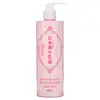What's inside
What's inside
 Key Ingredients
Key Ingredients

 Benefits
Benefits

 Concerns
Concerns

 Ingredients Side-by-side
Ingredients Side-by-side

Water
Skin ConditioningGlycerin
HumectantParaffinum Liquidum
EmollientTriethylhexanoin
MaskingRice Ferment Filtrate
Skin ConditioningGlutamic Acid
HumectantArginine
MaskingLeucine
Skin ConditioningGlycine
BufferingCeramide EOP
Skin ConditioningCeramide NP
Skin ConditioningCeramide AP
Skin ConditioningPlacental Protein
HumectantArbutin
AntioxidantDipotassium Glycyrrhizate
HumectantCholesterol
EmollientPhytosphingosine
Skin ConditioningSodium Lauroyl Lactylate
EmulsifyingPEG-9
HumectantDimethicone
EmollientPEG-20 Sorbitan Isostearate
EmulsifyingCarbomer
Emulsion StabilisingXanthan Gum
EmulsifyingDisodium EDTA
Phytic Acid
Behenyl Alcohol
EmollientPotassium Hydroxide
BufferingSilver Oxide
AntimicrobialPhenoxyethanol
PreservativeParfum
MaskingAcrylates/C10-30 Alkyl Acrylate Crosspolymer
Emulsion StabilisingWater, Glycerin, Paraffinum Liquidum, Triethylhexanoin, Rice Ferment Filtrate, Glutamic Acid, Arginine, Leucine, Glycine, Ceramide EOP, Ceramide NP, Ceramide AP, Placental Protein, Arbutin, Dipotassium Glycyrrhizate, Cholesterol, Phytosphingosine, Sodium Lauroyl Lactylate, PEG-9, Dimethicone, PEG-20 Sorbitan Isostearate, Carbomer, Xanthan Gum, Disodium EDTA, Phytic Acid, Behenyl Alcohol, Potassium Hydroxide, Silver Oxide, Phenoxyethanol, Parfum, Acrylates/C10-30 Alkyl Acrylate Crosspolymer
Centella Asiatica Extract
CleansingCentella Asiatica Leaf Extract
Skin ConditioningCentella Asiatica Root Extract
Skin ConditioningButylene Glycol
HumectantGlycerin
HumectantHelianthus Annuus Seed Oil
EmollientCaprylic/Capric Triglyceride
Masking1,2-Hexanediol
Skin ConditioningCetearyl Olivate
Sorbitan Olivate
EmulsifyingTriethylhexanoin
MaskingMacadamia Ternifolia Seed Oil
EmollientBeeswax
Emulsion StabilisingPanthenol
Skin ConditioningCetearyl Alcohol
EmollientEthylhexylglycerin
Skin ConditioningHydroxyethyl Acrylate/Sodium Acryloyldimethyl Taurate Copolymer
Emulsion StabilisingCyclohexasiloxane
EmollientAsiaticoside
AntioxidantMadecassic Acid
Skin ConditioningAsiatic Acid
Skin ConditioningArginine
MaskingMadecassoside
AntioxidantAllantoin
Skin ConditioningCarbomer
Emulsion StabilisingDimethicone/Vinyl Dimethicone Crosspolymer
Skin ConditioningSodium Hyaluronate
HumectantWater
Skin ConditioningPinus Pinaster Bark Extract
AntioxidantCentella Asiatica Extract, Centella Asiatica Leaf Extract, Centella Asiatica Root Extract, Butylene Glycol, Glycerin, Helianthus Annuus Seed Oil, Caprylic/Capric Triglyceride, 1,2-Hexanediol, Cetearyl Olivate, Sorbitan Olivate, Triethylhexanoin, Macadamia Ternifolia Seed Oil, Beeswax, Panthenol, Cetearyl Alcohol, Ethylhexylglycerin, Hydroxyethyl Acrylate/Sodium Acryloyldimethyl Taurate Copolymer, Cyclohexasiloxane, Asiaticoside, Madecassic Acid, Asiatic Acid, Arginine, Madecassoside, Allantoin, Carbomer, Dimethicone/Vinyl Dimethicone Crosspolymer, Sodium Hyaluronate, Water, Pinus Pinaster Bark Extract
Ingredients Explained
These ingredients are found in both products.
Ingredients higher up in an ingredient list are typically present in a larger amount.
Arginine is an amino acid that is important for human development. Your body uses is it to produce hair keratin and skin collagen.
As a cosmetic ingredient, Arginine has antioxidant properties and can also help repair damaged skin. This ingredient is derived either synthetically or from animals.
Arginine isn't fungal acne safe when used in the presence of other lipids (fats, fatty acids, oils, esters, etc). Oils and fats occur naturally within the skin, so take caution when using Arginine if you're prone to fungal acne.
Learn more about ArginineCarbomer is a polymer of acrylic acid. Its main role is to create a gel consistency.
A high amount of carbomer can cause pilling or balling up of products. Don't worry, most products contain 1% or less of carbomer.
Glycerin is already naturally found in your skin. It helps moisturize and protect your skin.
A study from 2016 found glycerin to be more effective as a humectant than AHAs and hyaluronic acid.
As a humectant, it helps the skin stay hydrated by pulling moisture to your skin. The low molecular weight of glycerin allows it to pull moisture into the deeper layers of your skin.
Hydrated skin improves your skin barrier; Your skin barrier helps protect against irritants and bacteria.
Glycerin has also been found to have antimicrobial and antiviral properties. Due to these properties, glycerin is often used in wound and burn treatments.
In cosmetics, glycerin is usually derived from plants such as soybean or palm. However, it can also be sourced from animals, such as tallow or animal fat.
This ingredient is organic, colorless, odorless, and non-toxic.
Glycerin is the name for this ingredient in American English. British English uses Glycerol/Glycerine.
Learn more about GlycerinTriethylhexanoin is created from glycerin and 2-ethylhexanoic acid. It is a solvent and emollient.
As a solvent, Triethylhexanoin helps dissolve ingredients to stable bases or help evenly distribute ingredients throughout the product.
It is also an emollient and helps condition the skin.
Learn more about TriethylhexanoinWater. It's the most common cosmetic ingredient of all. You'll usually see it at the top of ingredient lists, meaning that it makes up the largest part of the product.
So why is it so popular? Water most often acts as a solvent - this means that it helps dissolve other ingredients into the formulation.
You'll also recognize water as that liquid we all need to stay alive. If you see this, drink a glass of water. Stay hydrated!
Learn more about Water